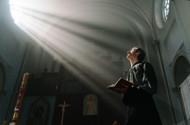A Priest's Ordination: What Clergy Wear on that Special Day
Aug 21st 2023
A priest's ordination is a significant and sacred event in the clergy's journey of faith and service. On this special day, clergy members wear specific attire that symbolizes their role and signifies their commitment to their vocation.
The garments worn during a priest's ordination hold deep spiritual and historical significance. The attire and vestments worn by clergy during a priest's ordination are very different from what they would wear before their ordination. But what happens during a priest’s ordination?
What Happens During a Priest's Ordination?
A priest's ordination is a sacred and significant event within the Catholic Church and other Christian denominations. It is a moment when an individual is called to serve as a minister of the faith and to carry out the duties and responsibilities of the priesthood.
It involves a series of liturgical rites and prayers that confer the sacrament of Holy Orders upon the candidate, transforming them into a priest. Throughout the ordination ceremony, bishops, priests, and other clerics fulfill distinct roles, each contributing to the significance and integrity of the event.
What a Priest Needs to Wear During the Ceremony
Throughout the ordination ritual, various vestments and ordination attire are worn to symbolize the responsibilities and authority that come with the priesthood.
Cassock and Surplice
The cassock is a long, ankle-length garment that serves as the foundation of clerical attire. It is typically black and is worn by clergy members as a daily garment. During the ordination, the cassock is often worn under other vestments.
The surplice is a loose-fitting, white garment that is worn over the cassock. It has wide sleeves and reaches to the knees. The surplice represents purity and is often worn during liturgical ceremonies, including ordinations.
Stole
The stole is a long, narrow strip of fabric that is worn around the neck and hangs down the front. It is typically decorated with symbolic designs or colors. The stole is an important liturgical vestment that represents the authority and responsibility of the priesthood.
During the ordination, the stole is worn in a specific manner to signify the newly ordained priest's reception of priestly authority.
Dalmatic and Chasuble
The dalmatic and chasuble are outer liturgical vestments that are worn over the cassock and stole. The dalmatic is a loose, sleeveless garment with wide sleeves that reaches to the knees. It is often worn by deacons during liturgical celebrations but may also be worn by priests during specific occasions, including ordinations.
During a priest's ordination, the newly ordained priest may wear the dalmatic and chasuble as part of the ritual, symbolizing the reception of priestly authority and the responsibility to serve the Church and its people.
Mitre and Crozier
The mitre and crozier are ceremonial items associated with bishops and archbishops. These items are not typically worn by priests during their ordination, often it is the typical bishop attire for the ordination of priests.
However, it is worth mentioning them as they are significant symbols within the hierarchy of the Catholic Church.
The mitre is a tall, pointed hat worn by bishops and archbishops. It symbolizes their authority and role as successors of the Apostles. The crozier is a staff with a curved top that represents the bishop's pastoral authority and care for the faithful.
The Role of Bishops
Bishops hold a position of authority within the Church and are responsible for overseeing the ordination of priests. Their primary role during a priest's ordination is to confer the sacrament of Holy Orders through the laying on of hands.
The bishop must wear the appropriate bishop attire for ordination during the rite. This act symbolizes the continuity of the priesthood from the time of the Apostles to the present day.
Bishops also lead the prayers of consecration and anoint the candidate's hands with holy chrism. Through these actions, bishops invoke the Holy Spirit's presence and power, consecrating the candidate's hands for the sacred work of the priesthood.
The Role of Priests
Priests, especially those who serve as mentors or formators, play a vital role in the preparation and formation of candidates for ordination. They provide spiritual guidance, theological instruction, and pastoral support throughout the discernment and training process.
During the ordination ceremony, priests may participate in various ways. They may assist the bishop in laying hands on the candidate, signifying the collective participation and support of the other priests in attendance.
The Role of Other Clerics
Other clerics, such as deacons and seminarians, also have roles during a priest's ordination. Deacons may assist with various liturgical tasks, such as carrying sacred vessels or assisting the bishop and priests in the ritual actions.
Seminarians, who are in the process of discerning and preparing for the priesthood, may have roles in the ordination ceremony as well. They participate as witnesses and supporters, representing the future generation of priests and demonstrating the continuity of the ministerial priesthood.
The Ordination is a Special Day for All Priests
A priest's ordination is a momentous occasion in the life of a clergy member. The attire and vestments worn during the ordination ceremony carry deep symbolism and significance. Every cleric, from the bishop to the seminarians, partake in the special event.
It's important that all bishops wear the proper bishop attire for the ordination rites, and everyone wear the right garment that represents the priest's role, authority, and commitment to serving God and the Church.
